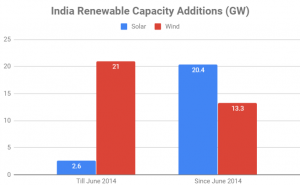According to data from the Ministry of New and Renewable Energy (MNRE), wind power was the clear winner till about 2014, but has clearly got left behind since then. The year 2014 was when the newly elected Modi government announced a five-fold increase in India’s solar power target.
As of June 2014, India had 21 GigaWatt (21,000 MW) of installed wind power capacity, while solar power capacity was just 2.63 GW.
 However, this changed fast over the last four years. Between June 2014 and June 2016, India added 20.4 GW of solar power capacity, but only 13.25 GW of wind power (see chart).
However, this changed fast over the last four years. Between June 2014 and June 2016, India added 20.4 GW of solar power capacity, but only 13.25 GW of wind power (see chart).
As a result, as of last month, India had 23.03 GW of installed solar power and 34.29 GW of installed wind power.
Part of the reason for the difference between solar and wind is the early incentives given for wind power projects.
About a decade ago, India introduced a system of giving ‘accelerated depreciation’ on money invested on wind projects. In other words, if a company invested Rs 100 cr on wind power, it could deduct that amount from its taxable profit, thus bringing down the overall tax that it had to pay. Any return from the sale of electricity added to the benefits.
Over the last three years, that system has been discontinued, and a reverse-bidding process introduced.
Under this system, the government will give contracts to set up large wind farms to those companies who promise to supply power at the lowest cost. However, the auction-based allocation of wind projects is yet to achieve its full run-rate.
In the year ended March, India produced about 102 bln units of power from renewable sources, or about 7.8% of the total.
Out of the 102 bln units of renewable power produced, nearly half, or 52.7 bln units, came from wind farms, 25.9 bln from solar, 11.8 from bagasse (sugarcane) and 7.7 bln units from small hydro power projects.
Reference- Ultra News, MNRE report, Financial Express






